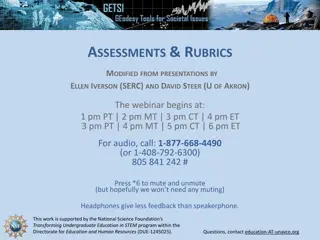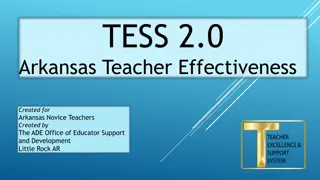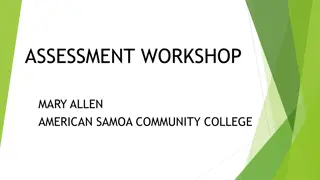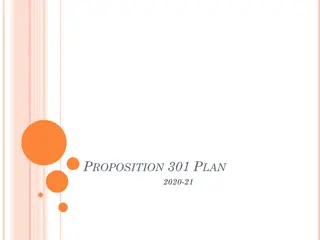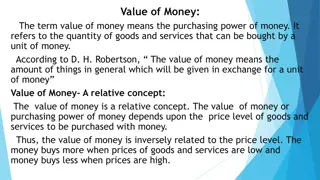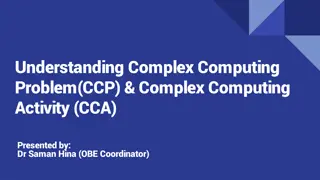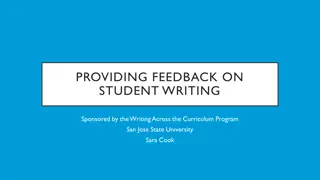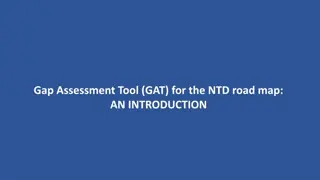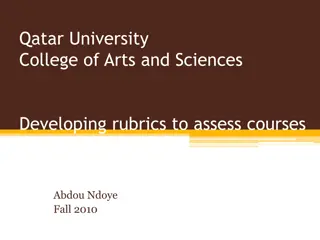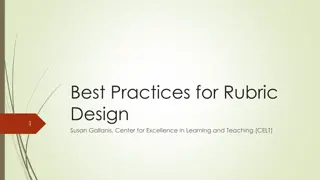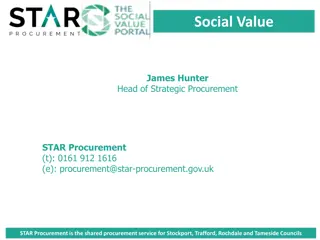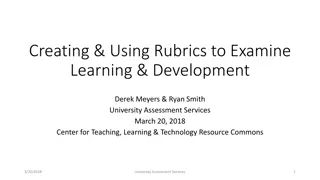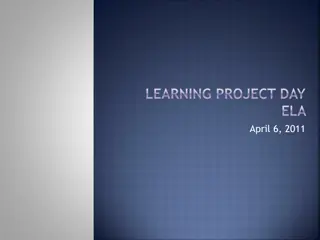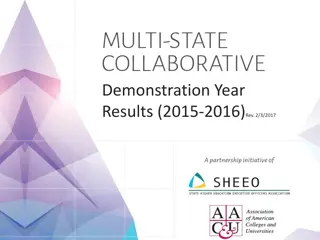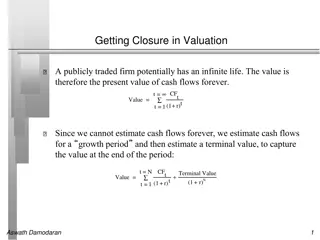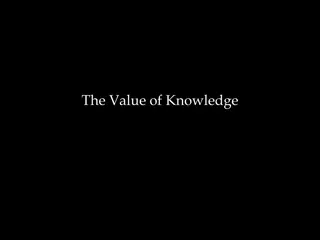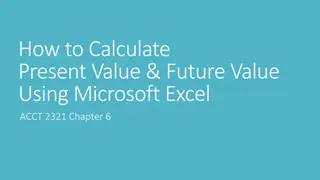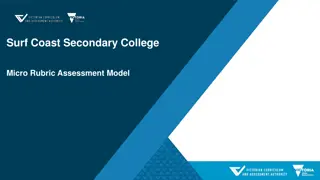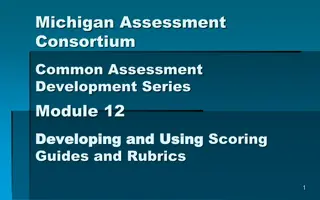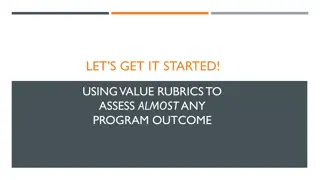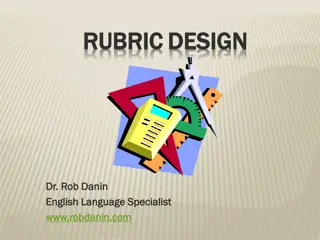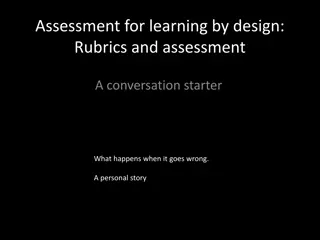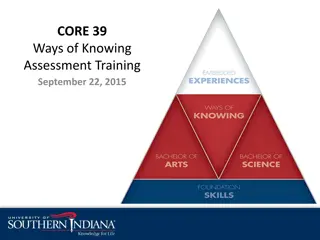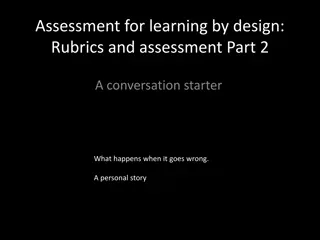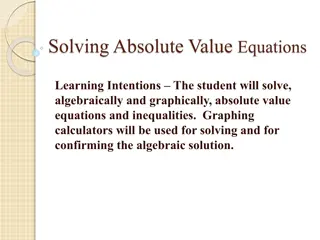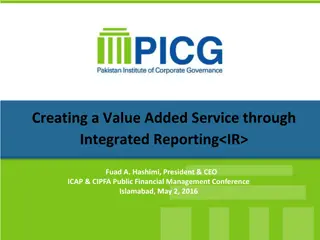Action Research Data Collection Methods Overview
Explore quantitative data collection methods such as checklists, rubrics, surveys, and rating scales for action research in education. Learn how these tools are used to assess student performance and gather valuable insights for refining teaching strategies. Discover the key characteristics and appl
4 views • 12 slides
Review of Grading Practices in PWCS and BRMS
This document outlines the assessment and grading practices in Prince William County Schools (PWCS) and Bull Run Middle School (BRMS) with a focus on providing feedback, enhancing student learning, and aligning assessments with learning outcomes. It includes information on assessment purposes, forma
3 views • 12 slides
ECC Social Value Reporting and Evaluation Framework
Essex County Council (ECC) has implemented a robust Social Value Reporting and Evaluation framework based on the Local Government Association's National TOMs method. This framework categorizes and assesses social value contributions in two parts - Value Score and Supporting Statement Score - to deri
3 views • 16 slides
ASSESSMENTS & RUBRICS
Enhance your understanding of assessments and rubrics in STEM education through a comprehensive webinar covering terminology, proposal strategies, and practical usage of materials design rubrics. Delve into setting learning goals, aligning outcomes, and designing instructional strategies for success
1 views • 25 slides
Understanding TESS 2.0: A Guide for Arkansas Novice Teachers
Explore the Teacher Effectiveness Support System (TESS) 2.0 specifically designed for novice teachers in Arkansas. Learn about effective teaching methods, guiding improvement through rubrics, and the essential components of teacher excellence outlined in the ESSA. Dive into the TESS framework, its f
1 views • 31 slides
Assessment Workshop at American Samoa Community College
Explore the process of assessment, including topics like rubrics, reliability, validity, data analysis, direct vs. indirect assessments, and examples of learning outcomes. Discover the strengths and methods of creating rubrics to evaluate student work effectively.
0 views • 74 slides
Proposition 301 Plan Overview for Teacher Compensation
The Proposition 301 Plan for the 2020-21 academic year outlines a structured approach to pay increases for teachers. It includes three components: a 20% increase to base salary, 40% for meeting performance goals, and 40% for duties fulfilled from a set list of menu items. The plan also details speci
0 views • 19 slides
Mastering AP Government FRQs: Tips for Success
Understanding the differences between FRQs and essays, grading rubrics, answering questions effectively, deciphering action verbs, and interpreting common task instructions for AP Government exam success.
1 views • 28 slides
Understanding the Value of Money and Standards
The value of money refers to its purchasing power, which is influenced by the price level of goods and services. Different standards, such as wholesale, retail, and labor, help measure the value of money. Money can have internal and external value, affecting domestic and foreign transactions. The Qu
0 views • 62 slides
Understanding Complex Computing Problem (CCP) and Complex Computing Activity (CCA)
Dr. Saman Hina, along with Dr. Farrukh Arif and Dr. Maria Waqas, presents information on Complex Computing Problem (CCP) - a problem involving technical, computing, and other issues with no obvious solution, requiring deep knowledge and analytical thinking. CCP is evaluated through predefined rubric
4 views • 19 slides
Enhancing Student Writing: Effective Feedback Strategies
Enhance student writing through effective feedback strategies sponsored by the Writing Across the Curriculum Program at San Jose State University. The feedback process is viewed as an opportunity to teach, emphasizing strengths, weaknesses, and improvement areas for students. Designing clear instruc
0 views • 60 slides
Understanding the Rule of Law and Legal Systems in Wales and England
The content discusses the nature of law, the Welsh and English legal systems, and the Rule of Law doctrine. It includes observations from the 2019 AS Law Unit 1 examination, emphasizing the importance of adhering to rubrics and answering questions clearly. Candidates faced challenges with timing and
0 views • 14 slides
Advancing NTD Roadmap through the 2022 Gap Assessment Tool (GAT) Introduction
Introducing the Gap Assessment Tool (GAT) for the NTD roadmap, focusing on disease-specific assessments like Schistosomiasis. The 2022 GAT aims for greater standardization and objectivity in assessment criteria across diseases with specific rubrics defined for each dimension.
0 views • 18 slides
Rubrics and Authentic Assessments in Course Evaluation at Qatar University
Workshop focused on developing rubrics for assessing courses at Qatar University College of Arts and Sciences. It covers the rationale for using rubrics, different assessment types, challenges of authentic assessment, and the role of rubrics in ensuring consistency and reliability in evaluating stud
0 views • 14 slides
Best Practices for Rubric Design in Teaching
Explore the key components of rubrics, understand their importance in assessment, and learn how to effectively design and use them to enhance student learning outcomes.
0 views • 18 slides
Enhancing Social Value through Strategic Procurement
STAR Procurement, the shared service for multiple councils, emphasizes the importance of Social Value in procurement practices. The Social Value Portal serves as a management tool to measure and demonstrate the benefits of Social Value commitments. Bidders are required to provide quantitative and qu
0 views • 14 slides
Understanding and Utilizing Rubrics for Assessment
A rubric is a scoring tool that outlines specific expectations for evaluating assignments or projects. This tool helps in identifying key criteria for assessment and provides a structured approach to grading. Rubrics play a vital role in enhancing learning outcomes and promoting consistency in evalu
0 views • 26 slides
Enhancing Feedback Strategies in ELA Learning Project Day
Refine understanding of ELA, engage with student exemplars, and design constructive feedback in a structured agenda. Activities include generating feedback, digging deeper into feedback processes, and considering the impact of timely and specific feedback on student growth in learning and skills. Co
0 views • 31 slides
Multi-State Collaborative for Advancing Quality Student Learning
Slides showcasing results from the demonstration year (2015-2016) of the Multi-State Collaborative for Advancing Quality Student Learning involving 12 states. Study findings reflect the use of common rubrics to assess student work and highlight the challenges and benefits of the VALUE rubrics. Facul
2 views • 32 slides
Integrated Value Creation in Corporate Finance
Explore the concept of integrated value creation in corporate finance, emphasizing the importance of managing for long-term value while incorporating social and environmental goals. Learn about responsible management practices that focus on creating net present value (NPV) through a balance of finan
0 views • 38 slides
Comprehensive Guide to Kindergarten Writing Training for NYSESLAT 2019
Explore a detailed guide on Kindergarten Writing Training for the NYSESLAT 2019 exam. The training covers four constructed-response types including Letter Writing, Word Writing, Sentence Writing, and Writing a Story. Gain insights into the application of holistic writing rubrics, analyzing student r
0 views • 24 slides
Understanding Terminal Value in Valuation
Valuation of publicly traded firms with potentially infinite lives involves estimating cash flows for a growth period and a terminal value to capture value at the end. The stable growth rate, which cannot exceed the economy's growth rate, plays a crucial role in determining the present value of futu
0 views • 8 slides
Maximizing Customer Value, Satisfaction & Loyalty in Business
Explore the essence of customer value, satisfaction, and loyalty in business success through Dr. Ananda Sabil Hussein's insightful perspective. Learn about customer perceived value, determinants of value, steps in value analysis, loyalty definitions, satisfaction measurements, and the significance o
0 views • 18 slides
The Value of Knowledge: A Philosophical Exploration
Exploring the value of knowledge through the lens of Plato's Meno Problem, this text delves into why knowledge is considered more valuable than mere true belief. It discusses Plato's solution to the problem, the secondary and tertiary value problems, and constraints on solutions and strategies in un
0 views • 22 slides
How to Calculate Present Value & Future Value Using Microsoft Excel
Learn how to calculate present value and future value using Microsoft Excel functions such as PV and FV. Understand the syntax, arguments, and examples for determining the value of single amounts, annuities, and lump sums. Step-by-step instructions provided for efficient financial calculations.
0 views • 14 slides
Understanding Micro Rubrics in Educational Assessment
A micro rubric is a detailed assessment tool used at the end of learning activities to evaluate student performance and guide self-reflection. It consists of levels ranging from "Not Submitted" to "Excelling" and helps students improve their work through targeted feedback. Micro rubrics differ from
0 views • 6 slides
Exploring Land Value Return and Recycling for Transportation Funding
With transportation investment needs surpassing available resources, investigating the potential of land value return and recycling as a revenue source can benefit public agencies. This involves recovering and reusing a portion of the increased land value generated by public investment in transporta
0 views • 33 slides
Mastering Rubrics: Types, Design, and Application
Understand the essentials of rubrics by exploring various types like checklists, rating scales, Likert-type scales, holistic, and analytic rubrics. Learn about the characteristics of good rubrics and how to create effective scoring guides. Get insights from examples like the University of Pittsburgh
0 views • 9 slides
Maximizing Shareholder Value Creation Through Strategic Business Practices
Explore the concept of shareholder value creation, the importance of generating revenues exceeding economic costs, and meeting shareholders' expectations. Learn about Economic Value Added (EVA), key value drivers, aligning strategy with value creation, and essential factors for overall business succ
0 views • 11 slides
Understanding Trade in Value-Added (TiVA) and Global Value Chains
Trade in Value-Added (TiVA) offers crucial insights into the complexities of global value chains and economic globalization. By shifting focus from gross trade statistics to value creation along supply chains, TiVA helps in formulating better policies and addressing systemic risks associated with ma
0 views • 22 slides
Developing and Using Scoring Guides and Rubrics in Assessment
Explore the importance of rubrics and scoring guides in assessment development, understanding different types of rubrics, developing and using them effectively, and addressing bias through objective criteria. Learn how rubrics help in evaluating student responses and providing feedback for improveme
0 views • 52 slides
Understanding Value Rubrics for Comprehensive Program Assessment
Explore the use of VALUE rubrics for assessing program outcomes, creating aligned assignments, collecting student work effectively, and improving student skills. Learn about AAC&U's 15 VALUE rubrics and their applications in course and program evaluation. Discover how to define performance level
0 views • 24 slides
Mastering Rubric Design for Effective Assessment
Rubrics are essential tools in evaluating and providing feedback on student performance. This comprehensive guide covers the definition, elements, and benefits of rubrics, along with expert tips on designing impactful rubrics for various assessments. Explore the art of rubric design, learn what make
0 views • 30 slides
Enhancing Assessment Practices Through Rubrics and Conversational Learning
Explore the critical aspects of rubrics in assessment design, including the distinction between holistic and analytical rubrics, their respective applications, and how they can be leveraged as learning tools. Discover the importance of aligning rubrics with course objectives and engaging students in
0 views • 10 slides
Economic Foundations of Imperialism: Exploitation and Value Transfer
Imperialism primarily functions as an economic mechanism for exploiting value rather than seeking political dominance. The transfer of value occurs through mechanisms like unequal exchange, global value chain flows, and capital flows, leading to the long-term appropriation of value by imperialist na
0 views • 28 slides
Streamlining the CORE 39 Assessment Process: A Closer Look at Rubrics and Deadlines
A detailed insight into the CORE 39 assessment process, focusing on the creation of rubrics aligned with key assignments. Learn about the formation of the CORE 39 Assessment Task Force and the use of Tk20 software for assessment. Important deadlines and the role of rubrics in grading are highlighted
0 views • 23 slides
Enhancing Assessment Practices through Effective Rubrics Design
Explore the importance of well-designed rubrics in assessment practices, focusing on avoiding pitfalls and maximizing student understanding. Learn how to create powerful rubrics that guide students towards essential learning outcomes. Gain insights on improving assessment strategies and fostering cl
0 views • 17 slides
Understanding Absolute Value Equations and Inequalities
In this lesson, students will learn to solve absolute value equations and inequalities both algebraically and graphically. The concept of absolute value, which represents the distance between a number and zero on the number line, is explained through examples and solutions. The importance of using g
0 views • 43 slides
Business Model Reporting for Value Creation
Integrated Reporting (IR) plays a crucial role in forging business partnerships and facilitating sound decision-making. Understanding the organizational business model is essential for long-term sustainability and value creation. The global approach to business model reporting encompasses business s
0 views • 42 slides
India Fellowship Seminar: Product Contributions to Growth, Risk Management, and Shareholder Value
India Fellowship Seminar discussed the contributions of participating and non-participating products to premium growth, risk management, and shareholder value. Key topics included market trends, drivers of shareholder value, PAR vs NPAR attractions, creating shareholder value, and risk management st
0 views • 21 slides



